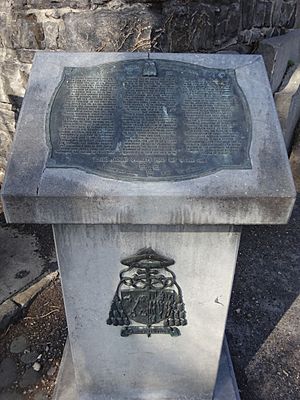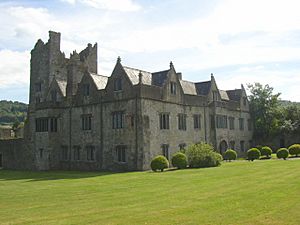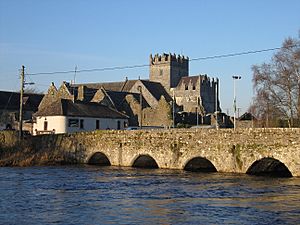Dermot O'Hurley facts for kids
Quick facts for kids The Most Reverend Dermot O'Hurley |
|
|---|---|
| Archbishop of Cashel | |

Memorial plaque at St. Kevin's Church, Camden Row, Dublin
|
|
| Archdiocese | Cashel |
| Appointed | September 1581 |
| Reign ended | 19 or 20 June 1584 |
| Predecessor | Maurice MacGibbon |
| Successor | David Kearney |
| Orders | |
| Ordination | 9 September 1581 |
| Consecration | 10 September 1581 by Pope Gregory XIII |
| Personal details | |
| Born | c. 1530 Lickadoon Castle, Lickadoon, Ballyneety, County Limerick, Lordship of Ireland |
| Died | 19 or 20 June 1584 Dublin, Ireland |
| Buried | St. Kevin's Church, Camden Row, Dublin, Ireland |
| Nationality | Irish |
| Denomination | Roman Catholic |
| Parents | William O'Hurley |
| Alma mater | University of Leuven |
| Sainthood | |
| Feast day | 20 June |
| Venerated in | Ireland |
| Title as Saint | Blessed |
| Beatified | 27 September 1992 Vatican City by Pope John Paul II |
| Shrines | St. Kevin's Church, Camden Row, Dublin, Ireland |
Dermot O'Hurley (around 1530 – June 19 or 20, 1584) was a Roman Catholic Archbishop in Cashel, Ireland. This was during a time when England was taking more control over Ireland. Archbishop O'Hurley was held and treated harshly in Dublin Castle. He was put to death because he was accused of going against the Queen. However, many believe he was truly killed because of the religious persecution of Catholics by Queen Elizabeth I. He is remembered as one of the 24 important Irish Catholic Martyrs. Pope John Paul II declared him "Blessed" on September 27, 1992.
Contents
Early Life and Education
Dermot O'Hurley was born around 1530. His family was part of the Gaelic nobility of Ireland. They lived near Emly, County Tipperary. His father, William, was a leader of the O'Hurley family. His mother, Honora Ni Brien, came from another important Irish family.
Dermot likely went to a school at a Cathedral in Emly. Later, his family moved to Lickadoon Castle in County Limerick. He had private teachers there. Then, he went to study at the Old University of Leuven in Belgium.
In 1551, he earned a Master of Arts degree. He also got a doctorate in Law. He became a professor of philosophy at the university. He taught there for 15 years. People knew him for his writings about Aristotle. In 1574, he became a professor of church law and civil law at Reims University in France. He taught there for four years.
Becoming an Archbishop
In 1570, Pope Pius V declared that Queen Elizabeth I was no longer part of the Catholic Church. This led to a war in Ireland called the Second Desmond Rebellion (1579–1583). This war was still happening when Dermot O'Hurley was asked to go to Ireland.
On September 11, 1581, the Pope chose him to be the Archbishop of Cashel. He was made a priest and then an archbishop. He began his journey to Ireland in 1583. The government in Dublin Castle knew about his appointment. Queen Elizabeth's spies and people who hunted priests were soon looking for him.
Archbishop O'Hurley's journey was very dangerous. There was a war between the Pope and England. But he accepted the risk. He arranged for a ship captain to secretly take him from France to Ireland. He landed at Holmpatrick Strand near Skerries, County Dublin, in the autumn of 1583. A priest named Father John Dillon met him. They went to Drogheda and stayed at an inn.
Unfortunately, Archbishop O'Hurley's letters were sent on a different ship. English pirates captured these letters. They gave them to the officials in Dublin.
The Archbishop and Father Dillon learned that the officials knew where they were. They decided to go to Slane Castle. There, Thomas Fleming, 10th Baron Slane, hid them. At one point, they even hid in a secret room called a priest hole. Archbishop O'Hurley also secretly visited other priests in Cavan. Cavan was the land of the O'Reilly family.
However, a judge named Sir Robert Dillon recognized O'Hurley at Slane Castle. He was the Baron's cousin. During dinner, the judge heard O'Hurley speak. He realized O'Hurley was a very smart and important person. He suspected O'Hurley was the new Archbishop.
Sir Robert Dillon investigated and found out who O'Hurley really was. He immediately told Dublin Castle. The Baron of Slane was then ordered to arrest Archbishop Dermot O'Hurley.

Meanwhile, the Archbishop had already left Slane Castle. He was staying with Thomas Butler, 10th Earl of Ormond. The Earl was a Protestant, but his family and many people under his rule were Catholic. The officials in Dublin Castle watched the Earl closely. They wanted to find a reason to accuse him of helping Catholics.
Even with the high risk, the Earl of Ormond seemed to protect Archbishop O'Hurley. He asked the Archbishop to stay in County Tipperary and only focus on religious matters. While at the Earl's home, Ormonde Castle, the Archbishop wrote a letter. He asked to meet with the Protestant Archbishop of Cashel, Dr. Miler Magrath. He suggested they could both practice their religions peacefully. The Earl of Ormond did not trust Dr. Magrath. He secretly kept the letter, which can still be seen today.
In September 1583, Archbishop O'Hurley visited Holy Cross Abbey. After his visit, Baron Slane met him at Ormonde Castle. The Baron explained the danger to his own family. So, the Archbishop agreed to go with him and surrender at Dublin Castle.
On their journey, they talked about another Catholic bishop who had become Protestant. Archbishop O'Hurley said, "Many who are brave before a challenge become scared when the difficult time comes. So that this doesn't happen to me, I pray daily for strength."
The Earl of Ormond was said to be insulted by the arrest of his guest. Some historians believe the Earl secretly worked with Baron Slane to arrange the arrest. Others say the Earl did everything he could to save the Archbishop.
Capture and Death

When officials in Dublin Castle learned that the Earl of Ormond was coming to Dublin, they decided to act quickly. They feared the Earl's influence might save Archbishop O'Hurley. On June 19, 1584, the Archbishop was quickly put on trial by a military court. His official papers, showing he was made an archbishop by the Pope, were used as proof against him.
The officials ordered that Archbishop Dermot O'Hurley be put to death. Early in the morning of June 19 or 20, 1584, O'Hurley was taken from Dublin Castle. Even though they tried to keep it secret, other Catholic prisoners noticed. They called out that O'Hurley was innocent. Another bishop, who had returned to Catholicism and was also imprisoned, shouted that O'Hurley was a holy man. The jailer then punished them to make them quiet.
The Archbishop was pulled on a wooden frame through the city gates. He was taken to a willow forest to be hanged. This was either in St Stephen's Green or at Hoggen Green. The usual place for hangings in Dublin was at Lower Baggot Street.
A group of Dublin citizens arrived unexpectedly at Hoggen Green. They had come to practice archery.
After his death, Archbishop O'Hurley's body was thrown into a nearby mass grave. However, his body was secretly dug up. It was placed in a wooden container by William Fitzsimon and reburied at night. This happened in a holy place at St. Kevin's Church, Camden Row, Dublin. Many people believe miracles have happened at his grave. It has been a place of special visits ever since.
Legacy and Remembrance
When news of his death spread, Catholics across Europe immediately saw O'Hurley as a martyr. Many stories of his life and death were printed and shared widely.
An English poet named Richard Verstegan wrote a detailed account of Archbishop O'Hurley's death. This was in a book published in 1587. The book included a picture showing O'Hurley and other Irish martyrs. This helped spread his story. Many other writers also wrote about Archbishop O'Hurley's life and death.
It is interesting to note that one of the officials who ordered O'Hurley's death, Archbishop Adam Loftus, later became an ancestor of Arthur Wellesley, 1st Duke of Wellington. The Duke of Wellington was a British Prime Minister. In 1829, he helped pass a law that gave Catholics more rights in Britain and Ireland. He convinced King George IV to agree to this law.
After Catholics gained more rights in 1829, people became more interested in Archbishop O'Hurley again. His story was republished. Historians continued to study his life.
In 1904, the Catholic Church in Ireland began to investigate Archbishop O'Hurley's life and death. They also looked into other Irish Catholic Martyrs. They found many important documents and letters. These included letters written by the very people who had treated him harshly and put him to death. Because his story was so well-documented, Archbishop O'Hurley was declared a "Servant of God." This was an important step towards becoming a saint.
In 1915, Pope Benedict XV officially allowed the process for Archbishop O'Hurley to become a saint to begin. More investigations happened between 1917 and 1930. The findings were sent to the Pope.
On September 27, 1992, Pope John Paul II declared O'Hurley "Blessed." Sixteen other Irish martyrs were also honored that day. After this, a special plaque was put up by the Dublin City Council at St Kevin's Churchyard to remember him.
Folklore
- For centuries, many people have visited Archbishop O'Hurley's tomb. Local stories say that on dark, stormy nights, people have seen his ghost. They say he appears to be celebrating a special Mass over his grave in St. Kevin's churchyard. The stories say that when he reaches a certain part of the Mass, both O'Hurley and the altar disappear, leaving only darkness.
See also
Sources
- McNeill, Charles (1911). "Dermond O'Hurley". Catholic Encyclopedia 11. New York: Robert Appleton.



